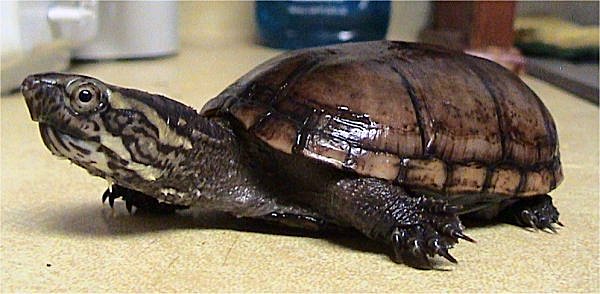| Place of Origin and Range |
Eastern mud turtles are found in the United States of Alabama, Arkansas, Delaware, Florida, Georgia, Illinois, Indiana, Kentucky, Louisiana, Maryland, Mississippi, Missouri, New Jersey, New York, North Carolina, Oklahoma, Pennsylvania, South Carolina, Tennessee, Texas, and Virginia. |
| Description |
The carapace is keelless, lacks any pattern, and varies in colour from yellowish to black. The plastron is large and double hinged, and can be yellowish to brown, and may sometimes have a dark pattern. The chin and throat are a yellowish grey, streaked and mottled with brown, while the limbs and tail are greyish. The eye, or iris, of the eastern mud turtle is yellow with dark clouding, and its feet are webbed. |
| Morph Patterns Available |
Yes |
| Adult Size |
Can grow up to 4 in(10cm) |
| Accommodation |
Eastern mud turtles live in ponds and other freshwater habitats. A filtered aquarium with water temperature at 70-80'F(21-26'C), and a sloping ramp(driftwood, textured plastic or some other non-abrasive surface) leading from the bottom to an illuminated and warmed basking spot. Approx 80'F(27'C). |
| Lifespan |
Can live 18+ years |
| Feeding / Diet |
Snails, crayfish, minnows, worms,insects, and prepared foods such as pelleted trout, catfish pellets, and koi goldfish pellets. |
| Other Considerations |
In Indiana, the eastern mud turtle is listed as an endangered species. Watch for theses health concerns carefully with your turtle. Vitamin A Deficiency: Vitamin A is an important nutrient for your turtle’s health. It is found in his diet in the form of leafy green, orange or yellow vegetables, liver, and fish. If your turtle is not getting enough Vitamin A, he can suffer serious health problems. Always check to make sure that your turtle does not have swollen eyelids, as this is the main sign of a Vitamin A deficiency. Also, check for weight loss, nasal discharge and infected skin. Any of these symptoms could point to a deficiency. If you think your turtle may not be getting enough Vitamin A, you should take him to the veterinarian to get a firm diagnosis. Shell Problems: Your turtle’s shell is very important to his overall health. There are many potential problems that could occur, so you should be on the lookout at all times. Respiratory Disease: Respiratory infections have symptoms similar to vitamin A deficiency, including swollen eyelids and runny nose, so you should take your turtle to the veterinarian to get a proper diagnosis if you suspect either. More serious infections will be characterized by breathing through the mouth, mucus in the mouth, and wheezing. Always make sure your turtle’s environment has the proper amount of humidity, as this will help prevent respiratory problems. |




